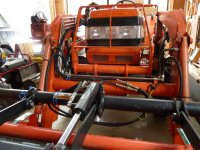Fxfymn
Silver Member
- Joined
- Mar 8, 2008
- Messages
- 163
- Location
- Fredericksburg, VA
- Tractor
- Kubota L4060 HST, FEL; Kubota BX2660
Has anyone come up with a way to add permanent pipng to your FEL for the grapple as opposed to running hose up the loader arms?
I am currently using a rear remote on my L3430 plumbed to the grapple by hose connected to QDs at the rear loader mount and at the grapple. In the four years I have used this arrangement I have bunged up the hoses running up the loader arms a couple of times. No big deal at $15 - $20, but it would be nice to match the OE tubing that runs up the loader arms and just use a short piece of hose to connect the grapple.
I assume I can buy the tubing from Kubota, but I can't imagine what that would cost based on quotes I have gotten for other hydraulic parts from my local dealer.
Anybody have a better idea?
I am currently using a rear remote on my L3430 plumbed to the grapple by hose connected to QDs at the rear loader mount and at the grapple. In the four years I have used this arrangement I have bunged up the hoses running up the loader arms a couple of times. No big deal at $15 - $20, but it would be nice to match the OE tubing that runs up the loader arms and just use a short piece of hose to connect the grapple.
I assume I can buy the tubing from Kubota, but I can't imagine what that would cost based on quotes I have gotten for other hydraulic parts from my local dealer.
Anybody have a better idea?
